
full spec comparison chart can be found here at BHphoto
I provided ChatGPT with the full Canon R6 III specifications and transcripts from a dozen respected YouTube reviewers, then asked it to create a detailed comparison between the Canon R6 III and the Sony A7 IV.
📸 SENSOR & IMAGE QUALITY
Canon R6 Mark III: 32.5 MP BSI CMOS (non-stacked)
Sony A7 IV: 33 MP BSI CMOS (non-stacked)
➡ Tie – Both sensors are very close in resolution and dynamic range.
⚡ SPEED & BUFFER
Canon: 12 fps (mechanical) / 40 fps (electronic) + RAW pre-capture (≈ 0.5 s before press)
Sony: 10 fps max (mechanical or electronic) (no pre-capture)
➡ Canon wins by far – 4× faster, pre-capture records before you even react, and the new CFexpress Type B slot clears buffers up to 5× faster. Wildlife testers confirmed ≈ 200 RAWs at 40 fps before slowdown.
🎯 AUTOFOCUS & SUBJECT DETECTION
Canon: Dual Pixel AF II + Deep Learning AI, registers faces (10 people / 6 groups), tracks animals, birds, vehicles with face priority. Works down to –6.5 EV.
Sony: Real-Time Tracking AF with human & animal eye AF (+ bird mode since firmware v2.0). Works down to –4 EV.
➡ Canon wins – The new “face registration” and steadier small-subject tracking outperform Sony’s AF in complex scenes.
🪄 STABILIZATION
Canon: up to 8.5 stops IBIS + lens IS sync
Sony: 5.5 stops IBIS
➡ Canon clearly ahead – Stable handheld video even at 600–1200 mm and razor-sharp 1/5 s stills.
🎥 VIDEO CAPABILITIES
| Feature |
Canon R6 III |
Sony A7 IV |
| Max Resolution |
7K RAW Open Gate → 4K |
4K 60 (1.5× crop) |
| 4K 60 / 120 |
No crop 60 / slight crop 120 |
Crop 60 / no 120 |
| Bit Depth & Codecs |
12-bit RAW / 10-bit C-Log 2 & 3 / HLG / PQ |
10-bit 4:2:2 S-Cinetone |
| HDMI |
Full-size |
Full-size |
| Overheating |
Moderate (≈ 30 min 4K60 @ 22 °C before 2 bars) |
Minimal but lower data rates |
➡ Canon wins decisively – 7K RAW oversample, C-Log 2/3, waveforms, false color and full HDMI bring it into pro-video territory. Sony is strong for hybrid use but less advanced for video work.
🧠 REAL-WORLD USABILITY
Canon’s field tests highlight its wildlife excellence: fast, accurate AF; reliable tracking on tiny birds; impressive high-ISO sharpness (up to ISO 12 800 clean). Pre-capture proved “game-changing.” Sony feels slower for bursts and less intuitive in AF-mode switching.
🌙 LOW-LIGHT & DYNAMIC RANGE
Both perform well up to ISO 12 800. Canon’s BSI design offers strong detail retention; Sony retains slightly more shadow latitude at base ISO.
➡ Tie / slight Canon edge at high ISO; Sony edge in shadow dynamic range.
📁 MEDIA & CONNECTIVITY
Canon: CF Express Type B + UHS-II SD, full HDMI, mic + headphone, USB-C PD power.
Sony: 2× UHS-II SD (or limited CF Express Type A slot).
➡ Canon wins – faster cards, pro connectors, cleaner tethering.
🔋 BATTERY & THERMALS
Canon: LP-E6P battery, good thermal control (but 7K RAW heats up).
Sony: NP-FZ100 battery = slightly longer photo runtime.
➡ Tie – Canon better for video power, Sony for stills longevity.
💡 ERGONOMICS & BUILD
Both are weather-sealed magnesium bodies. Canon’s grip and menus are praised for comfort; Sony for customization.
➡ Canon favored by most reviewers for handling and workflow.
💰 PRICE (Nov 2025)
Canon R6 III ≈ € 2 799 / $ 2 799
Sony A7 IV ≈ € 1 949 / $ 1 998
➡ Sony wins on price (≈ $ 800 less).
| Category |
Winner |
| Resolution |
Tie |
| Speed / Burst |
Canon R6 III |
| Autofocus |
Canon R6 III |
| IBIS |
Canon R6 III |
| Video |
Canon R6 III |
| Dynamic Range |
Slight Sony |
| Battery Life |
Slight Sony |
| Ergonomics / Ease |
Canon R6 III |
| Price / Value |
Sony A7 IV |
🔥 FINAL TAKE
If you’re a hybrid shooter or wildlife / sports photographer, → Canon R6 Mark III is the clear winner: faster bursts, pre-capture, superior AF, 8.5-stop IBIS, and pro-grade video tools.
If you’re budget-conscious or primarily a portrait / studio shooter, → Sony A7 IV remains an excellent alternative with mature color workflow, longer battery life, and slightly better shadow recovery.




